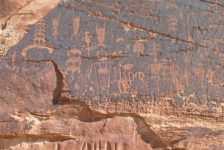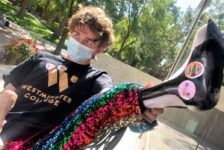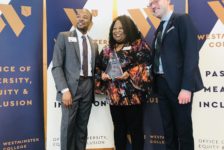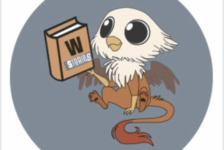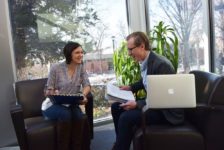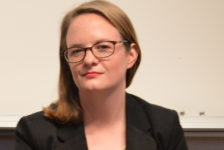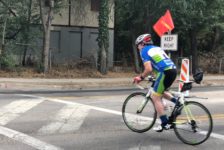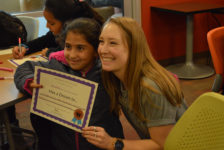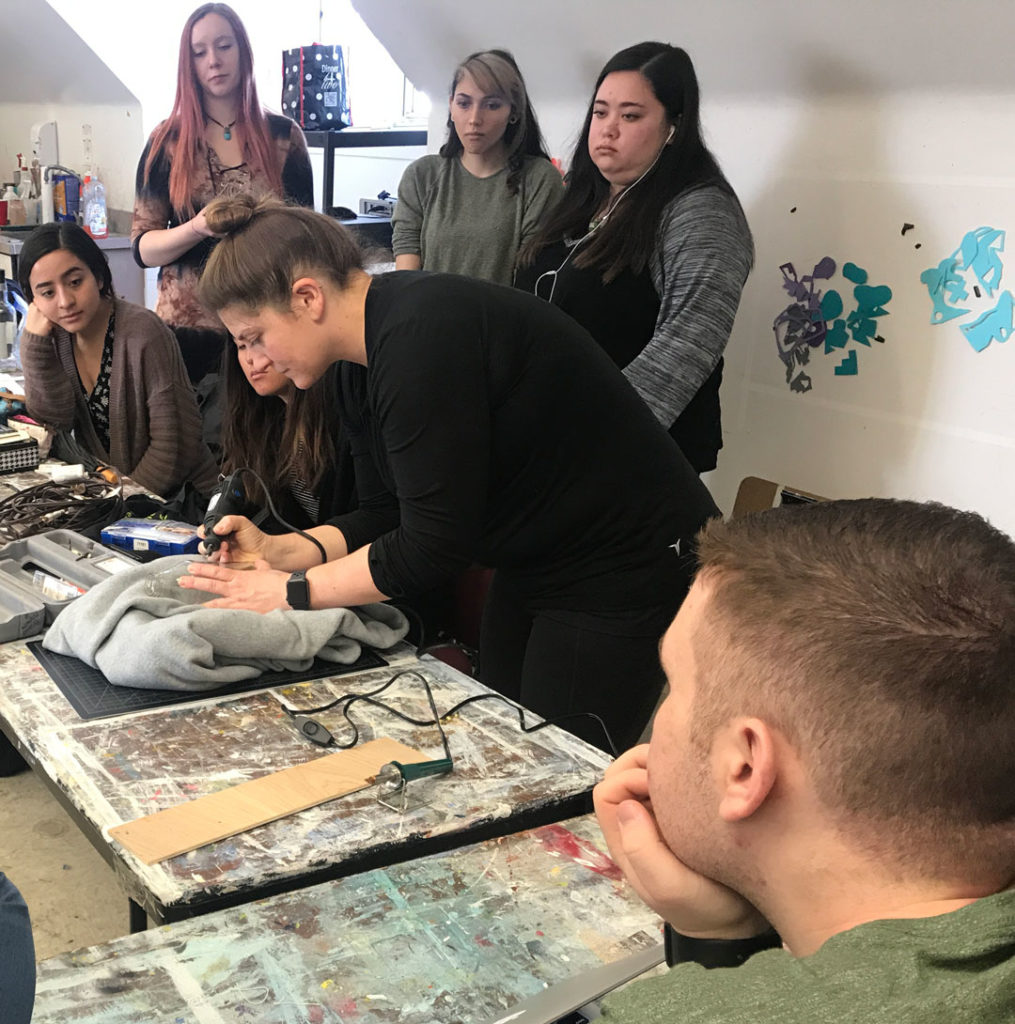
Naomi Marine, an art professor at Westminster College, shows her Composition and Design class how to use tools that can cut into glass or burn into wood for their next project. Marine said she sets up her classes using non-traditional materials and free-association brainstorming techniques to push students to think outside of clichés. (Photo by Jacqueline Williams)
Art classes are among the more creative and subjective courses available for students at Westminster College — which can make learning objectives and grading rubrics challenging.
Naomi Marine, an art professor at Westminster and at the University of Utah, said she aims to teach students how to think through their ideas and turn them into something tangible. When she sets up her classes, she said she uses non-traditional materials and free-association brainstorming techniques to challenge students to think outside of clichés.
“Naomi’s classes, especially her intermediate drawing class, pushed me further outside my comfort zone and inspired me more than probably any other art class,” said Meera Edwards, a senior art major who has taken several of Marine’s classes. “I learned how to work with various materials and media differently in her classes and how to really challenge myself.”
Marine sat down with The Forum to talk about her processes as a professor and how she grades art assignments. This interview has been lightly edited for clarity and conciseness.
Q: Art can be more subjective than something like math. How do you go about making a rubric and grading assignments?
A: If I like it or not or if it’s ‘good’ or not is subjective. But we could quantify or see if, ‘Did they do the research to come up with the idea?’ ‘Did they vet the idea?’ ‘Did they try three different solutions before they came up with what they ended up making their drawing about?’ And then just trying to communicate those ahead of time so everyone knows what those objectives are and then talking about it through [a class] critique and stuff.
Q: How do you create your curriculum for each class and still foster creativity?
A: If I’m starting from scratch, like I did with [Composition] and Design when I started, there’s usually that conversation with the department head: ‘What’s the goal in students taking this? What does it prepare them for?’ And then I definitely looked at some textbooks, a bunch of different basic design textbooks… And so I try to make it [a mix of] vetting ideas and also having the tools to express those ideas. And then sometimes I experiment within that. But once that major parameter has been established, then I think, for me, that’s the curriculum core.
Q: Did you always know you wanted to be an art professor?
A: No. I’ve always been an artist. My mom is an artist, so it’s just like part of what we do… We’re creative and she would give me weird materials and we would play around with stuff. And I used to play teacher because my dad teaches fourth grade, so I really liked standing at a board with a piece of chalk. But I think teaching art as a profession was something that came through undergrad and grad school and thinking, ‘Okay, well, what do I do with my degrees? Am I trying to make it as a professional artist just making work?’ And for me that felt kind of out of my comfort zone. And teaching is, I don’t know, kind of fits what I like, which is investigation and, like, being enthusiastic and working with other people and their ideas.
Q: You teach at the University of Utah (the U) and Westminster. What’s that like? What’s different about the two schools?
A: It’s very busy. But I teach different classes, so for me there’s kind of more of a divide than perhaps if I taught drawing and design at the U as well. So at the U I teach, there’s sculpture foundations classes… [It’s the] same process of trying to teach students how to come up with ideas and how to vet those ideas, how to experiment — but then just different materials. And big school versus small school. It’s like Westminster — I’m sure this is why students came [here] — but you get this more intense, you know, eight people in the class kind of a thing, which I think is really nice because you get to know students really well.
Q: Is there a piece of your own work that has inspired or influenced a project you assigned to your students?
A: Probably some of my material exploration influences assignments because that’s what I love as opposed to more formalist assignments. Like, I know some teachers want more time with still-life or something like that because that’s what they love — a minute capturing of certain colors or being able to figure out formal arrangements of things. [But] I think tend to, I mean, I care about those, but I emphasize them less than like creative crazy exploration. So I think that comes from me. I try not to otherwise impart my bias. I mean, I like things like teeny-tiny pen marks and stuff like that from my work. But I don’t think I have any assignments that are specifically set up like, ‘You have to do this.’
Q: When you say material exploration, what do you mean?
A: That’s where you find something that’s not — or maybe not necessarily — an art material that we’d be familiar with, like found object projects we do in [Composition] and Design. And you see what’s possible. How could you take it apart? How could you then put it back together? Visually what does it communicate to have torn up pages from an old book compared to torn up pages from, you know, like white copy paper? Because those two things communicate differently. So that kind of material exploration. Or just making accidents, right? So making little ink puddles where you just squirt out something to see what happens and then you flick some graphite in it. Or, someone this semester did like, gesso and they did little curves of gesso with a scraper and then they took graphite powder and blew it into it, and it made the coolest little moon-stippling stuff. I would never have thought of that. I’d never seen it before. I think they were just experimenting and it turned into this really cool thing.
Q: What do you love about your job?
A: I think working with college students is going to keep me younger. That’s a silly thing, but actually as I get older and my age grows from like — I used to be 23 and students were anywhere between 18 and older than me. And now I’m 34. And I just… there are so many ideas — especially at Westminster, where I think people are more engaged, aware of what’s going on or advocating for different things. That’s actually one of the big differences between here and the U sometimes, actually. But that kind of keeps me from just being stuck in one way of thinking about things because you get those new challenges. And then I mean, I wear gym clothes every day to work and I work with materials. And I get to talk with people, which is sometimes kind of hard but is also a lot of fun when you have this specified channel and you’re communicating about art.

